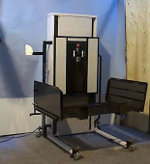The Wheelchair Guide
Your Wheelchair and Mobility Scooter Resource
Wheelchair Lifts, The Inexpensive Elevator Alternative
Tuesday, March 16th, 2010 at 12:22 pm
 Wheelchairs are a powerful tool used to help those who have difficulty walking or getting around. There are many types of wheelchairs, including sports wheelchairs, manual wheelchairs, and electric wheelchairs. While incredibly useful, one common problem among wheelchair users is accessing areas that have staircases. One option to increase accessibility is to use a vertical platform lift.
Wheelchairs are a powerful tool used to help those who have difficulty walking or getting around. There are many types of wheelchairs, including sports wheelchairs, manual wheelchairs, and electric wheelchairs. While incredibly useful, one common problem among wheelchair users is accessing areas that have staircases. One option to increase accessibility is to use a vertical platform lift.
Vertical platform lifts are basically small elevators, but unlike a regular elevator, the unit is entirely self contained. Vertical platform lifts, which are also called porch lifts and wheelchair lifts, are placed next to the landing of a staircase and raise vertically to the top of the landing. Depending on the model, some porch lifts can raise up to 12 feet, which is rather high for a front porch.
Vertical platform lifts are similar to stair lifts, in that they are designed to be used by those who have difficulty using the stairs. However, unlike a stair lift, which only provides a chair or small platform to stand on, it is possible to drive a wheelchair directly onto the vertical platform lift. As a result, they can be used with manual wheelchairs, electric wheelchairs, and even mobility scooters, with most supporting over 500 pounds of weight.
Installing a wheelchair lift is usually very easy, but it requires a sturdy base that is capable of not only supporting the weight of the wheelchair lift, but also the people using it. The base should be made out of concrete or wood and it is very important to consider drainage as well. Proper drainage will prevent water from pooling up under the wheelchair lift, as well as keeping the area around it free from mud or pooled water. It is also important to consider roof water runoff, so it is important to have gutters installed above the wheelchair lift if it is to be installed under an overhang. Also, care should be taken to remove any limbs that may fall on the wheelchair lift during a storm.
Aside from a sturdy base, the only main requirement is that there is enough room next to the landing to install the wheelchair lift. This is because the platform of the wheelchair lift moves vertically from the ground to the landing and back down again, so it must be able to be placed next to the staircases landing. As a result, wheelchair lifts will often not work on interior staircases. In this case, a special platform stair lift is used, which uses a platform attached to a metal track running the length of the staircase to transport the wheelchair user. However, the exception to this rule is in commercial settings, such as schools and churches, where it is often possible to install the wheelchair lift directly next to the staircase’s landing.
Wheelchair lifts offer a very easy and cost effective way of making the home more accessible to wheelchair users, but many people still prefer to use a ramp. The main advantage of a wheelchair ramp is that it is usually considerably less expensive than a wheelchair lift, especially if you build it out of wood.